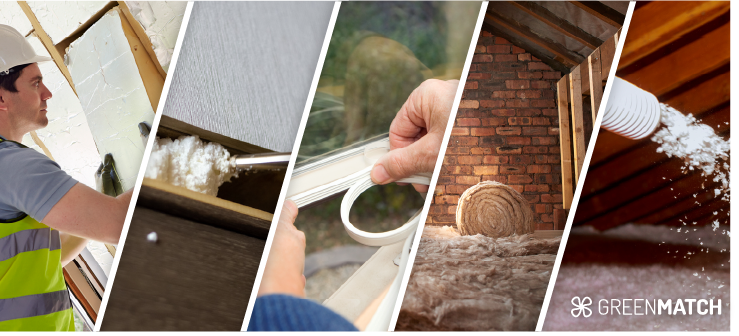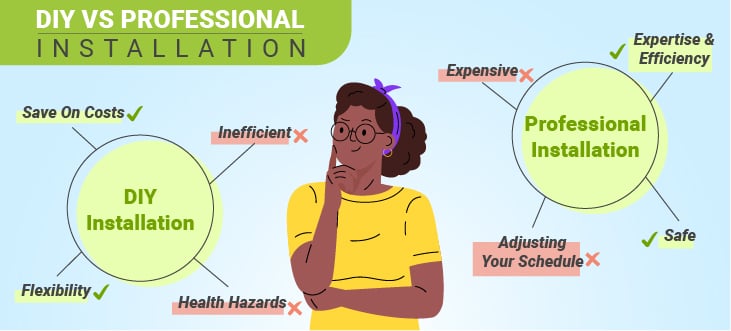You will be redirected to a Leads.io registration page.

Get up to 3 quotes from our selected suppliers by filling in only 1 form

Save money by comparing quotes and choosing the most competitive offer

Our service is 100% free and with no obligation
- GreenMatch.com
- Insulation
Insulation – Basics, Materials, and Types
What Insulation is Right for Your Home?

Insulation is the unsung hero of American homes. Insulation helps keep your home warm, prevents rodent invasion, and also helps save on your energy bills. It is predicted that by 2025, the thermal insulation market will have grown up to 3.4 billion.
So what is insulation?... Insulation is a barrier that blocks the transfer of thermal energy (heat) into and from your home. As a result, it keeps your home warm during winter and cooler during summer. Simply put, insulation is a way of preventing heat loss, noise reduction, and adding comfort to your home by using insulating materials throughout your home. The commonly insulated areas in your home are roofs, walls, attics, windows, doors, and floors.
In order to understand how insulation works it is important to understand how heat flow works. There are three basic mechanisms to heat flow – convection, conduction, and radiation. Convection is when heat is transferred through liquids and gases. As a result, warm air which is lighter rises and cold air, which is denser sinks toward the floor. Conduction is when heat moves through objects or materials. For e.g. when a spoon placed in a cup of hot coffee transfers heat through the spoon onto your hand, it’s called conduction. Radiation is when heat travels in a straight line and heats up whatever solid object comes in its path.
In order to understand how insulation works it is important to understand how heat flow works. There are three basic mechanisms to heat flow – convection, conduction, and radiation. Convection is when heat is transferred through liquids and gases. As a result, warm air which is lighter rises and cold air, which is denser sinks toward the floor. Conduction is when heat moves through objects or materials. For e.g. when a spoon placed in a cup of hot coffee transfers heat through the spoon onto your hand, it’s called conduction. Radiation is when heat travels in a straight line and heats up whatever solid object comes in its path.
Basically, heat flows from warmer to cooler areas to maintain a balanced temperature throughout your home. During the winter season, heat flows from warmer to cooler areas such as attics, garages, and outdoors. The heat flows into your home from the outdoors during summer. The heating and cooling system works to maintain balanced temperatures in your home during the winter and summer respectively.
Proper insulation ensures minimal heat flow, which can occur through ceilings, walls, floors, etc., in turn minimizing the working of your heating/cooling system and your energy bills. Generally, insulating materials slow down the conductive and convective heat flow throughout your home. To minimize the radiant heat flow, reflective insulation and radiant barriers are used.
The efficiency of an insulating material is judged by its thermal resistance, also known as the R-value. In simpler terms, R-value is a measure of an insulating material’s ability to resist the heat travelling through it. Hence, the higher the R-value, the higher its efficiency as an insulating material.
Fill in the form in just 1 minute
What are the different types of insulation?
There are two main types of insulation – open cell insulation and closed insulation. Both these insulations are effective, depending on how and where they are used. They each have sub-types that are used based on the area that needs insulating.
Open cell insulation – These insulations are structured in a way where the cells or bubbles in the material are interconnected but are at a distance. This makes the material more flexible and allows air to pass through but at a slower rate. Fibreglass, mineral wool, spray foam, and radiant barriers are all open cell insulators.
Closed cell insulation – In these insulations, the cells are not connected to each other, making it difficult for heat to pass easily. Spray foam and mineral wool insulators are also available as closed cell insulations. These insulators have higher R-value but are also expensive.
5 common types of insulation

The most common types of insulation that you should know about are:
Batt insulation: Batt insulation is available in pre-cut blankets or rolls, typically made of fiberglass, cellulose, plastic, natural fibres, or mineral wool. It is pre-cut to fit snugly between the standard width of attic rafters, wall studs or ceiling joists. Batt insulation is relatively easy to install, which makes it a popular choice for DIY projects. However, when it comes to tight spaces or irregularly shaped areas, installation becomes tricky. You may want to contact a professional to get the work done properly.
Blown-in insulation: Blown-in insulation, also known as loose-fill insulation, is made of materials like cellulose, fiberglass, or rock wool. It is installed using a machine that blows the insulation into the areas you’re insulating. This type of insulation is ideal for wall cavities, attics, or other hard-to-reach areas. If you’re looking to retrofit your existing structure, blown-in insulation is a good option since it can be installed without tearing down walls or ceilings.
Spray foam insulation: Spray foam insulation is a liquid insulation made of polyurethane.
It is sprayed into an area that needs insulating, where it then expands to fill the space
Foam board insulation: Foam board is a rigid insulation, generally made of materials like polystyrene, polyisocyanurate, or polyurethane. This insulation is generally used on the exterior of a building, or under the siding or roofing. This type of insulation provides a higher level of insulation, more so because it is resistant to moisture and mold.
Radiant barrier or reflective insulation: Radiant barrier or reflective insulation is made of aluminum foil or other reflective materials. This insulation is designed to reflect radiant heat away from your home, instead of absorbing it. This reflective insulation is usually installed in the attics, under roofs, or on walls. A radiant barrier is most effective for hot and sunny climates.
What are the different insulation materials?
Each of the above mentioned insulation types is made of various materials. These materials are used depending on the area that is being insulated and the type of insulation being installed. The most commonly used insulation materials include the following:
Choosing the right insulation material or the type of insulation is very important. Depending on the area you are looking to insulate, the material and type of insulation need to be chosen accordingly. Professional insulation installers would be in a better position to help you identify this.
At GreenMatch we can help you get in touch with certified installers to make this task easy for you. The usual process would entail you spending several hours researching and calling installers one by one and discussing your requirements. All you need to do is simply click on the button below and we will do this for you. We can get you in touch with up to three installers and their quotes for you to compare. Our service is free with no obligation.
Fill in the form in just 1 minute
Why should you insulate your home?

Insulation will help you keep the desired temperature in your house all year round, protecting it against cold in winter and excess heat in summer. Insulation is also useful to reduce noise pollution. A well-insulated house is very energy efficient and will need very little additional heating and cooling.
How much money you will save by insulating your home will depend on different factors like the type of insulation and the size of your house. Moreover, depending on how old your house is, you will need to incorporate more or fewer insulation measures. The good thing is that you generally don’t need any planning permission for fitting insulation measures and they will eventually pay back so it is a wise investment.
Usually, modern houses are built to very good insulation standards, but old houses need a lot of work to be done. In the last case, there are probably many options to improve the energy efficiency of your house. When too cold, heat can be lost in all directions, so you should think of integral insulation to keep the heat in your house.
You can choose to insulate your roof, floors, walls, windows, and doors. The most important thing is the walls since for a typical house the walls will lose around 30 to 40 percent of the heat. The roof comes in second place, accounting for approximately 25% of heat loss. Then come windows and doors with 20% and finally, the floor.
Insulation: DIY or professional installation?

Many homeowners in the US would prefer to opt to make insulation a DIY project. But is this really a good idea? Let’s take a look.
One of the biggest advantages of DIY insulation is that you can save on costs. Purchasing and installing insulation by yourself can allow you to save significantly on labour costs. If you opt for professional installation, labour costs can make the project quite expensive.
DIY insulation projects also allow you to work on the project more flexibly, according to your time and schedule. You can start, work, and finish the project at your convenience. You would not have to worry about adjusting your schedules and time with that of the installers’.
Although, having a professional installer do the insulation can ensure expertise and efficiency in the work done. It may not be possible for you to achieve the expert perfection that a professional installer can achieve. Moreover, you may also need to be aware of certain regulations that are to be followed when insulating your home. If not, you may end up violating them.
Health hazards are another concern. There are insulations that can especially be injurious to your health if proper precautions aren’t taken. Having the work done by a professional can certainly save you from any potential health hazards. However, if you are determined to go ahead with the DIY project, ensure that you are wearing the required protective gear.
As you can see, there are pros and cons to both sides of the coin. There is no reason you cannot take up insulation as a DIY project. If you are determined, have the required knowledge and are also looking to keep it light on your pocket, DIY insulation is definitely a good option. Otherwise, getting a professional installer’s help is always an option.
The question is, how to find the right installer. You will be required to spend hours calling one installer after the other, requesting quotes depending on your requirements. Once you have the quotes, you’ll sit and sort through them, trying to find the one that best suits your budget and requirements. GreenMatch can make this lengthy, tedious task easy for you. Simply click on the button below and we will get you in touch with up to three installers and their quotes for you to compare.
Fill in the form in just 1 minute
Frequently Asked Questions
The best insulation is usually dependent on the area you are looking to insulate. The most common insulations used are spray foam, blown-in, batt, foam board, and radiant barrier.
DIY insulation is a good option if you have the required time and expertise, and at the same time are looking for a more budget-friendly option. However, for expert and safer insulation, professional installers are always available to help you out.
Spray foam insulation is usually the one that lasts longer. However, there are other insulation options that depending on the area of the home may prove to be a better option. Seeking professional advice can prove helpful in such situations.
We strive to connect our customers with the right product and supplier. Would you like to be part of GreenMatch?

